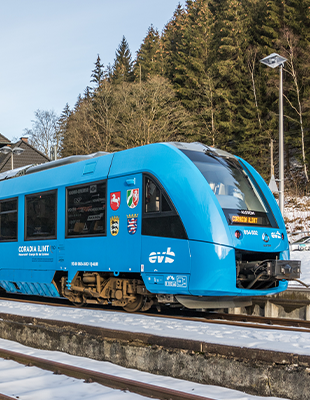The UK Government has committed to decarbonising all sectors of the UK economy to achieve our 2050 Net Zero target. Of the c16,000km of UK rail network, currently only 38% electrified, therefore the rail sector has a significant role to play in removing reliance upon diesel trains. Network Rail’s 2020 Traction Decarbonisation Network Strategy sets out the aspiration to remove diesel trains from the network by 2040.
The Challenge
To electrify sufficient rail network for the 2040 target would require significant additional construction output compared to what has been achieved in recent years. Between 2013 and 2019, just 747km of electrification works were completed, yet only 2.2km in the year from April 2021 to March 2022. Continuation of this construction output rate of electrified track would completely fail to reach the net zero target.
The environmental and economic costs of traditional Overhead Line Equipment (OLE) can be justifiable when it comes to highly trafficked main lines. However, the UK’s network consists of thousands of kilometres of rural and lightly trafficked routes, for which alternative fuels technologies may have better credentials from economic, environmental and social value standpoints.
Hydrogen – An Alternative Solution?
Hydrogen trains can run on existing tracks without the need for significant volumes of new fixed infrastructure like OLE. There are of course additional requirements around hydrogen fuel storage, distribution and refuelling, as well as considering how the hydrogen is fundamentally generated, in evaluating the decarbonisation options.
According to the Office for Rail and Road (ORR), the amount of total traction diesel consumption between April 2021 and March 2022 rose to 552 million litres, resulting in emissions of more than 1.48 billion kgCO2. Diesel costs are expected to increase (without taking into account geo-political situations) by a further 17%. between 2023 and 2030. As a direct comparison, to travel the same distance on the rail network for diesel and hydrogen trains, it can be determined the current diesel crossover cost for hydrogen is between £8.37/kg and £10/kg.
Between 2017 and 2021 there was an annual average of 2.2TWh of curtailed wind generation (lost electricity) across the UK, as the wind doesn’t always blow and the sun doesn’t always shine when we actually want to use the generated renewable electricity. Using ‘curtailed’ renewable energy to produce green hydrogen as an ‘energy vector’, has the potential to generate hydrogen for the rail sector. Curtailed energy during this period could have generated 46,000 tonnes of hydrogen; enough to power 75 million miles of train services (assuming a three-car train) and offsetting around 300 million litres of diesel and 800 million kgCO2.
Case Study Example
Taking the North Wales Main Line (NWML) as a case study example, the 170km line from Crewe to Holyhead has long been identified as a candidate for electrification. It has a challenging topography and is moderately complex for traditional electrification, so would have an indicative cost in the region of £1 billion. In the current economic climate, it is likely to fall some way down the priority scale.
To service the current daily service pattern on the NWML would require c 4.5 tonnes/day of hydrogen to operate, requiring approximately 225MWh/day of electrical input. Off-shore wind-turbines arrays, such as the 160 turbines in use at the c3.6MW Gwynt y Môr array in North Wales could generate sufficient electrolysed green hydrogen could via just 14 wind turbines or the curtailed energy already going to waste.
Conclusion
There are significant shipping port infrastructure developments underway to import hydrogen and clean fuels derivatives such as ammonia, which require distributing at scale. As an existing asset, this could be a golden opportunity for our UK rail freight network, to simultaneously decarbonise rail freight and passenger services as a significant demand use case, whist distributing clean fuels at scale to decarbonise wider industries.
Hydrogen offers a compelling case to decarbonise rail routes, especially in the following cases:
- Where centres for operation and refuelling can be closely aligned to existing or proposed renewable energy and hydrogen generation or import.
- In medium/lightly trafficked routes, where fixed electrification costs and embodied carbon affect the business case.
- Where complimentary hydrogen uses can drive cost efficiencies – i.e. sharing hydrogen production with nearby industrial facilities.
The cost of hydrogen will rapidly fall as the hydrogen economy grows, making the business case more favourable as the technology matures.
Hydrogen is not an Energy Transition panacea and will need to form part of an energy mix with low, zero and negative carbon solutions to remove diesel from the UK rail network. In highly-trafficked routes, fixed electrification will likely remain a preferred option, and battery/hybrid trains will play an important role in ‘bridging’ between areas of fixed electrification.
Using hydrogen, battery, and electrification as complimentary technologies, can rapidly accelerate decarbonisation of our UK rail network, help achieve the 2040 target for removal of diesel trains and support the UK in achieving our net zero targets. Implemented in a strategic manner, using curtailed renewable electricity aligned to the location and proximity of hydrogen production facilities and utilising rail freight distribution of clean fuels to enable hydrogen rail refuelling at scale, could deliver a step change for integrated decarbonised mobility at scale.

Paul Aspinall
Global Hydrogen Lead


